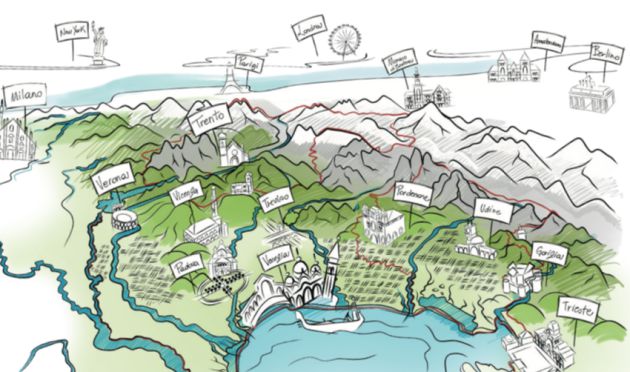
Pinot Grigio - the end of the affair?
Ines Salpico reports on a strategic rethink as sales of Italy’s favourite white experiences a dramatic fall.
The Pinot Grigio delle Venezie DOC Consorzio recently hosted its first congress to discuss current and future challenges both in terms of production and market placement. The event’s heading - The Values of the Pinot Grigio delle Venezie DOC – hinted explicitly at the perplexities faced by the producers. Following the stunning success of the Pinot Grigio (PG) phenomenon, they have come to depend on the large volume exports of the varietal’s entry-level wines. Changes and increasing pressures in the main export markets (USA and UK) clearly demand some strategic rethinking.
The 2018 vintage was the second year in which single varietal PG hailing from the Triveneto – an area also known as Tre Venezie, covering Veneto, Friuli-Venezia Giulia and Trentino-Alto Adige/Südtirol - was bottled under the Pinot Grigio delle Venezie DOC. Created in 2016, the new denomination was the result of the combined lobbying efforts of multiple producers from the three regions, now all gathered under the Consorzio di Tutela della DOC Pinot Grigio delle Venezie’s umbrella.
At the congress two guest speakers, Emma Dawson MW and Christy Canterbury MW, were invited to contextualise the scenario and challenges for PG consumption and sales in those key markets. They were also asked to give their views on how the new DOC might claim a sense of origin and penetrate more premium sectors.
This is a key concern for the Consorzio in a time when consumer behaviour, especially at low price levels, is changing dramatically.
Dawson questioned whether the UK has reached “peak PG”. The variety is seeing the strongest sales decline (8%) in the off-trade, in line with an overall decrease of 9% for all Italian wines (Nielsen, 12 months to 23 March 2019).
And in the on-trade, where Italy still performs well (5% growth), PG also declined, by 5% (CGA, 12 months to 23 March 2019).
As Dawson explained, British consumers are drinking less but better, increasingly emphasising sustainable attributes, and favouring more expressive, fruit-forward styles (which would explain the sustained growth of off-trade sales for Sauvignon Blanc).
On the other hand, the collapse of the mid-market casual dining sector - and crucially of some key Italy-focused chains - along with a shift in on-trade consumption from still to sparkling wines (the latter is in 12% growth) further suggests why the ubiquity of PG in the UK market is under threat.
The challenges in the US market are different, but no less complex. Canterbury’s presentation was eye-opening for many of the producers in the audience: the American consumer remains relatively loyal to the PG brand but does not associate any specific provenance with it. If a cheaper bottle is available on the same supermarket shelf, this will likely be the label of choice, regardless of whether it contains a PG produced in Italy or California (where plantings of the variety have been steadily increasing).
If ‘going Premium’ seems a possible way to cope with all the issues laid on the table at the congress, this will certainly not be an easy or straightforward goal to achieve. As Dawson candidly stated, Italian PG remains anathema to sommeliers in the high-end on-trade.
The inception of the Consorzio – and the creation of the DOC – may have been an initial response to the impending crisis over a mass-produced wine sold as commodity, and thus without emphasising a sense of origin in favour of easy market penetration and consumer understanding.
But can an all-encompassing DOC that in itself erodes the nuances of terroir across the different regions, along with an enduring commitment to a neutral wine style, be the answer?
Certainly not if premium market penetration is one of the key goals.
Italian PG producers are therefore confronted with a dilemma they themselves created: by foregoing specificity and variability they were able to bank on scalability and fast growth without developing any discerning consumer engagement. Strategic repositioning therefore requires some soul-searching about quality, style and price level.
It might be worth looking at what is already happening with Prosecco DOC, for which subzones and specific DOCGs have begun to distance themselves from the Prosecco deluge, educating the consumer about the granularity of terroirs and the different quality levels they can produce.
Dealing with the possible unravelling of the PG phenomenon will not be an easy task for Italy’s producers. But the social and economic importance that many of the stakeholders in the Consorzio have gained through and because of it does make a case for the joint effort.
Changing the mindset of producers, as much as of consumers, might be a fundamental part of the equation.
Pinot Grigio delle Venezie DOC in numbers:
• 25,810ha under vine
• 43% of world’s plantings of Pinot Grigio
• 82% of total Italian production of the variety
• 95% of total production exported, of which 37% to the USA, 27% to the UK and 10% to Germany
• 1.74 million hl produced in 2018
Source: Consorzio di Tutela della DOC Pinot Grigio delle Venezie (2018 data)
Keywords:
- wine
- UK
- Italy
- sales
- white
- market
- decline
- USA
- Pinot Grigio delle Venezie DOC
- PG
- Emma Dawson MW
- Christy Canterbury MW
- Triveneto
- Ines Salpicon
- The Values of the Pinot Grigio delle Venezia DOC
- congress




